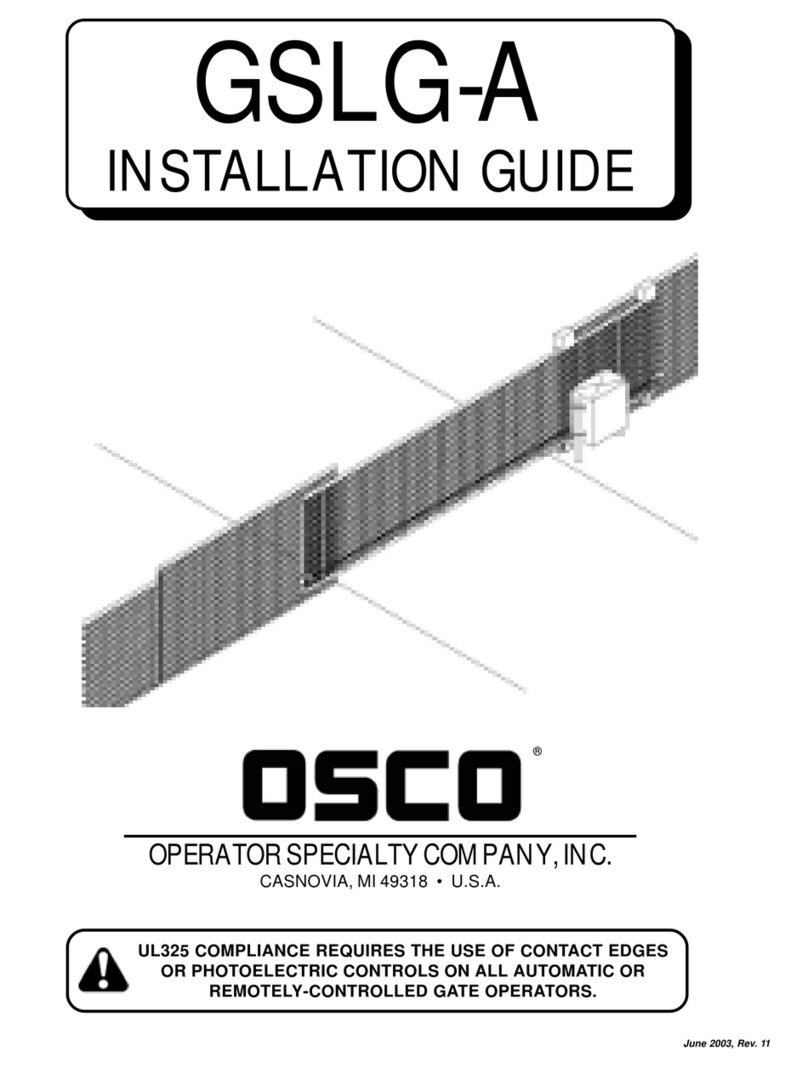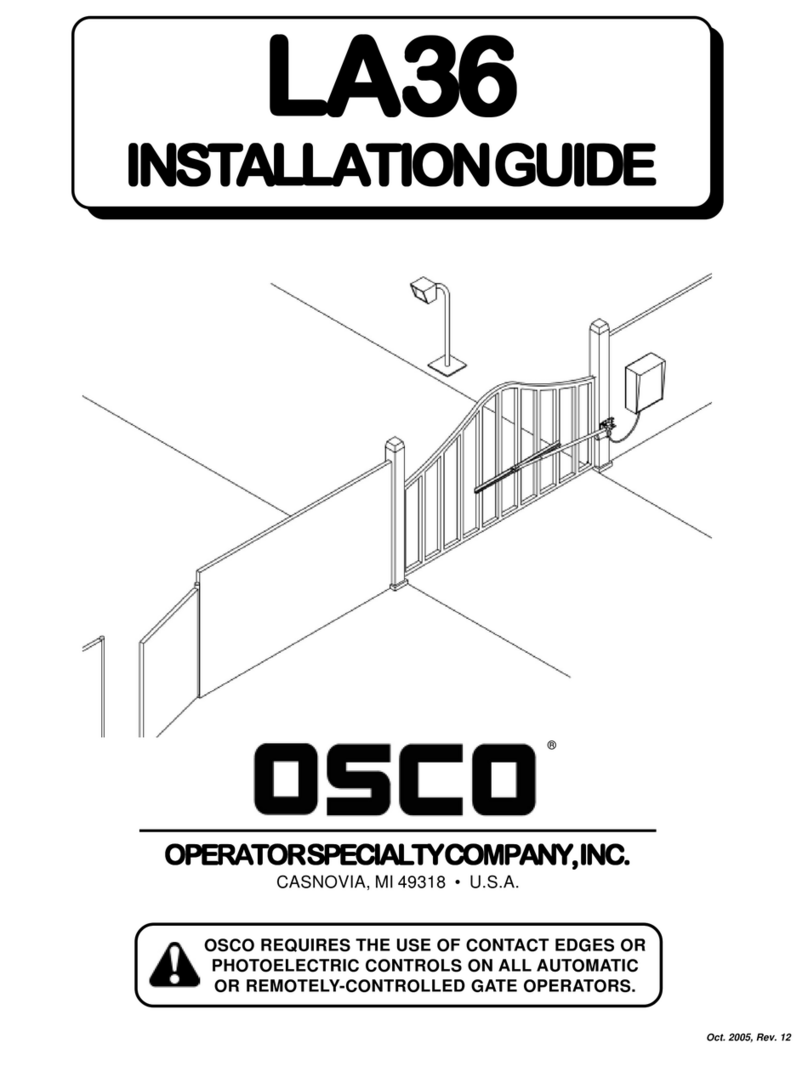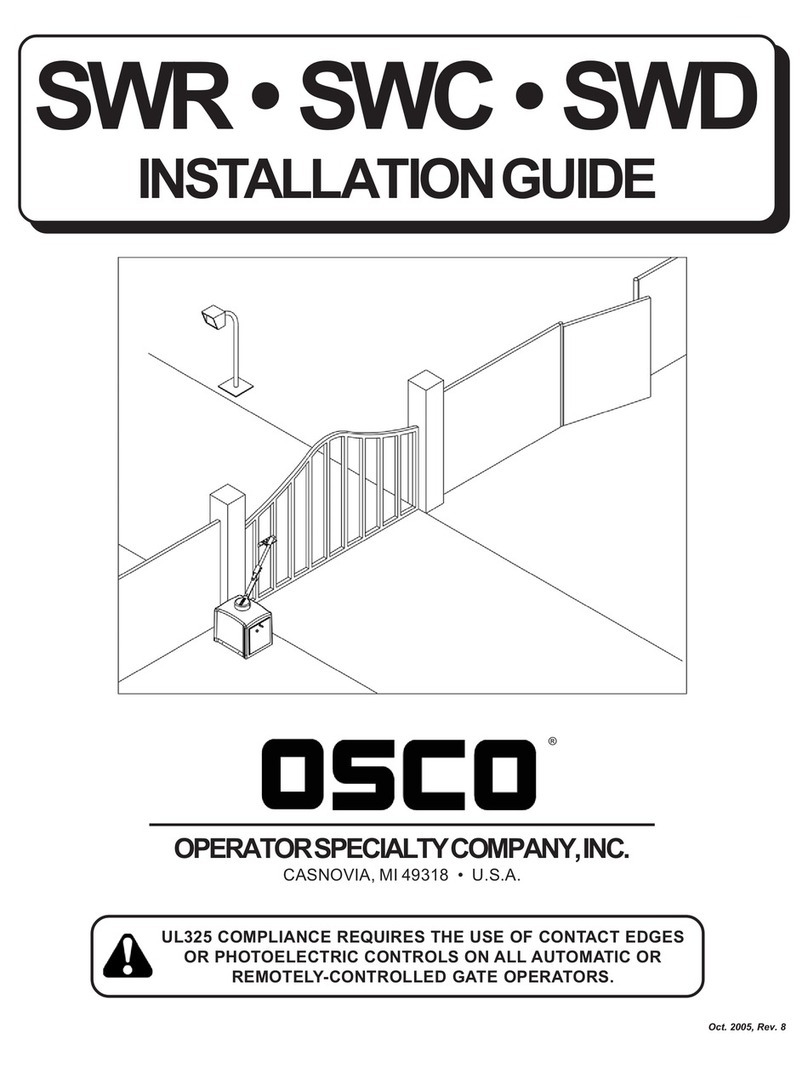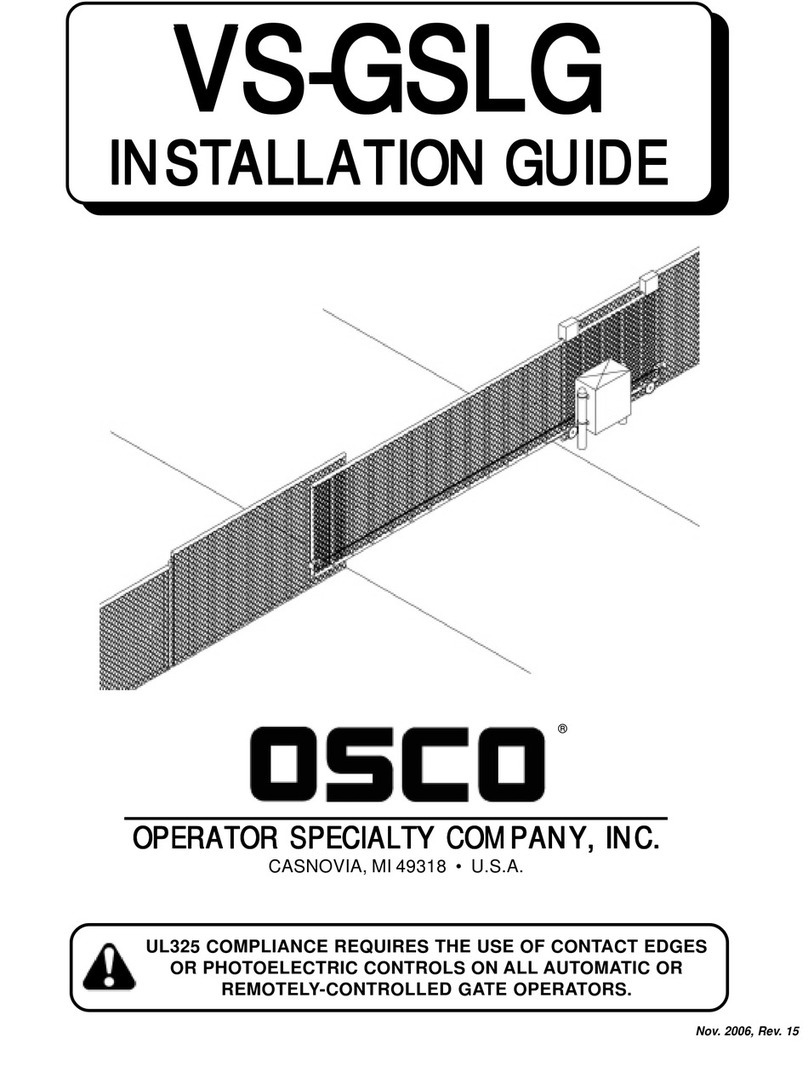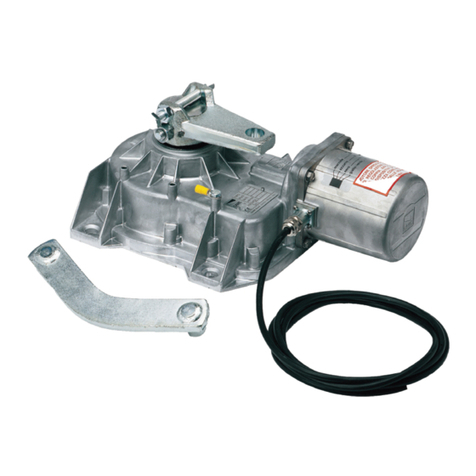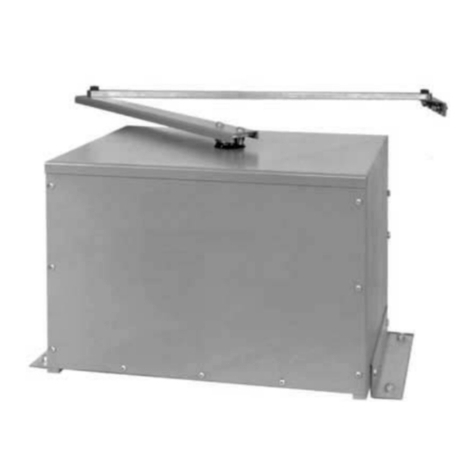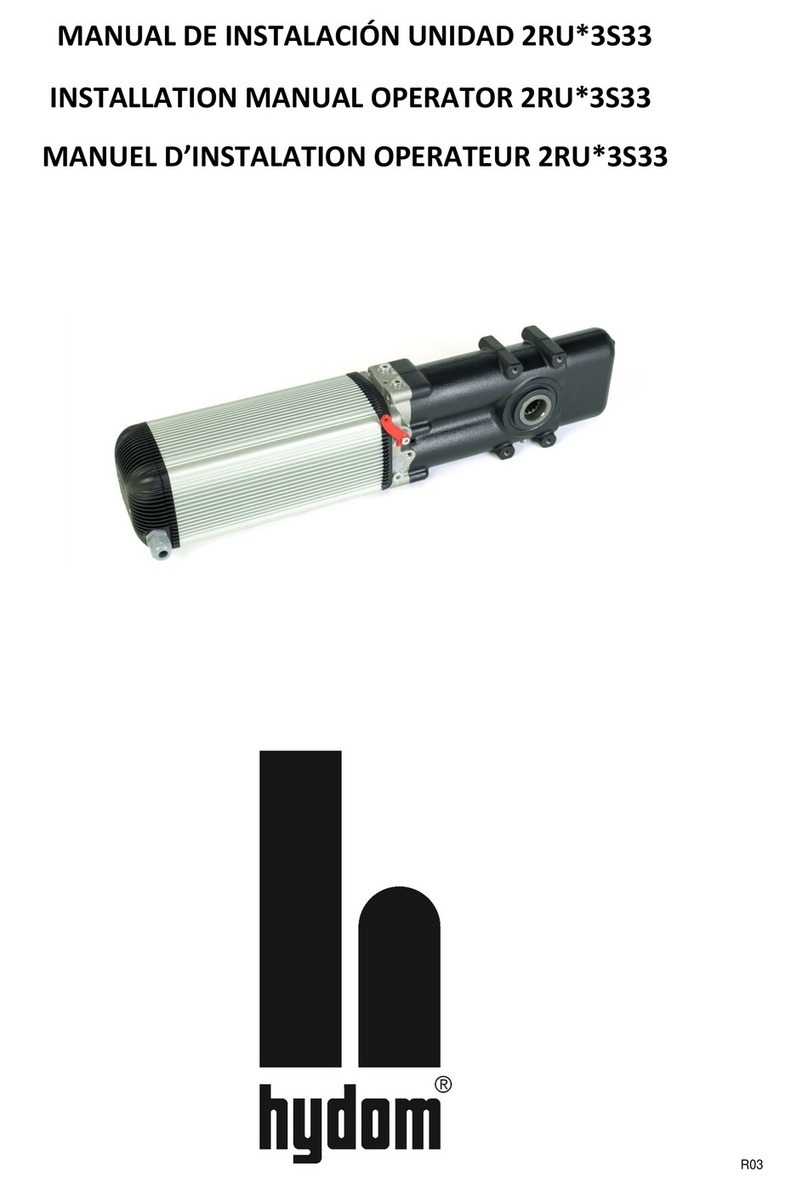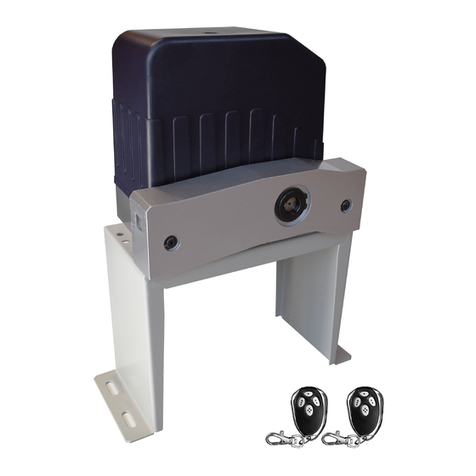OSCO MSG-A User manual

Aug. 2003, Rev. 15
UL325 COMPLIANCE REQUIRES THE USE OF CONTACT EDGES
OR PHOTOELECTRIC CONTROLS ON ALL AUTOMATIC OR
REMOTELY-CONTROLLED GATE OPERATORS.
OPERATOR SPECIALTY COMPANY, INC.
CASNOVIA, MI 49318 • U.S.A.
®
MSG-A • MSG-D
INSTALLATION GUIDE

MSG-A • MSG-D OPERATOR INSTALLATION GUIDE
- 2 -
TABLE OF CONTENTS
CAUTION!
DO NOT INSTALL
CONTROLS ON OR
NEAR THE GATE
CAUTION!
DO NOT INSTALL
CONTROLS ON
THE OPERATOR
PRE-INSTALLATION INFORMATION
Gate Operator Classifications ......................................................................................................................................................... 3
Safety Information and Warnings .................................................................................................................................................... 3
Pre-Installation Information ............................................................................................................................................................. 3
Warranty ........................................................................................................................................................................................... 3
INSTALLATION
Wiring Specifications ....................................................................................................................................................................... 4
Post and Pad Mounting Instructions ............................................................................................................................................... 5
String Method for Nonstandard Installation of Swing Gate Operators ........................................................................................... 6
Articulating -Style Arm Assembly Instructions ................................................................................................................................. 7
Vent Plug Installation ....................................................................................................................................................................... 8
Torque Limiter Adjustment .............................................................................................................................................................. 8
Electrical Connection and Adjustments .......................................................................................................................................... 9
Limit Cam Adjustments ................................................................................................................................................................... 9
CONTROL BOARD ADJUSTMENTS and ACCESSORY CONNECTIONS
Control Board Adjustments ........................................................................................................................................................... 10
Terminal Connection Descriptions ............................................................................................................................................... 11
Current Sensing Adjustments ....................................................................................................................................................... 12
Close Direction Current Sense Adjustment ................................................................................................................................. 12
Open Direction Current Sense Adjustment .................................................................................................................................. 12
Maximum Run Timer Adjustment .................................................................................................................................................. 12
Auto Close Timer Adjustment ....................................................................................................................................................... 12
Master/Slave Connection .............................................................................................................................................................. 12
Battery Back-Up Charger Board Configuration ............................................................................................................................. 12
Onboard L.E.D. Indicator Descriptions ......................................................................................................................................... 13
Important Notes for Installation of Master/Slave Applications ...................................................................................................... 14
Surge Protector Instructions .......................................................................................................................................................... 14
Charger Board Sleep Mode ........................................................................................................................................................... 15
Control and Accessory Connection Illustrations .................................................................................................................... 16-19
ILLUSTRATIONS
Loop Layout Illustration ................................................................................................................................................................. 20
Edge Layout Illustration #1 ............................................................................................................................................................ 21
Photo Eye Illustration ..................................................................................................................................................................... 22
TROUBLESHOOTING .......................................................................................................................................................................... 23
PARTS LISTS
How to Order Replacement Parts ................................................................................................................................................. 23
Model MSG-A Mechanical Parts Exploded View ........................................................................................................................... 24
Model MSG-A Mechanical Parts List ............................................................................................................................................. 25
Model MSG-A Control Box Exploded View and Parts List ............................................................................................................. 26
Model MSG-A Gate Arm Assembly Parts List ................................................................................................................................ 27
Model MSG-D Mechanical Parts Exploded View ........................................................................................................................... 28
Model MSG-D Mechanical Parts List ............................................................................................................................................. 29
Model MSG-D Control Box Exploded View and Parts List ............................................................................................................ 30
Model MSG-D Gate Arm Assembly Parts List ............................................................................................................................... 31
Model MSG-D Battery Maintenance and Brush Replacement ...................................................................................................... 32
PREVENTATIVE MAINTENANCE ......................................................................................................................................................... 35
GATE OPERATOR INSTALLATION CHECKLIST .................................................................................................................................. 36
CAUTION!
ONLY QUALIFIED SERVICE
TECHNICIANS SHOULD
WORK ON AN OSCO
SWING GATE OPERATOR

MSG-A • MSG-D OPERATOR INSTALLATION GUIDE
- 3 -
Read the following before beginning to install OSCO swing
gate operators:
1. Read the orange “Safety Instructions” brochure enclosed
with the packet of information. If you do not have one,
please call OSCO at 1-800-333-1717 to request one. Read
and follow all instructions.
2. All electrical connections to the power supply must be
made by a licensed electrician and must observe all
national and local electrical codes.
3. A separate power-disconnect switch should be located
near the operator so that primary power can be turned off
when necessary.
4. Install the enclosed warning signs on both sides of the
gate. Each sign must be plainly visible from the side of
the gate on which they are mounted.
5. Never reach between, through or around the fence to
operate the gate.
6. You must install all required safety equipment.
GATE OPERATOR
CLASSIFICATIONS
All gate operators can be divided into one of four different
classifications, depending on their design and usage.
Class I Residential Vehicular Gate Operator
A vehicular gate operator intended for use in a home of one to
four single family dwellings, or garage or parking area associ-
ated with these dwellings.
Class II Commercial / General Access Vehicular Gate
Operator
A vehicular gate operator intended for use in a commercial
location or building such as a multifamily housing unit of five
or more single family units, hotel, retail store or other building
servicing the general public.
Class III Industrial / Limited Access Vehicular Gate
Operator
A vehicular gate operator intended for use in an industrial
location or building such as a factory or loading dock area or
other location not intended to service the general public.
Class IV Restricted Access Vehicular Gate Operator
A vehicular gate operator intended for use in a guarded indus-
trial location or building such as an airport security area or
other restricted access locations not servicing the general
public, in which unauthorized access is prevented via supervi-
sion by security personnel.
PRE-INSTALLATION
INFORMATION
Before unpacking, inspect the carton for exterior damage. If
you find damage, advise the delivery carrier of a potential claim.
Inspect your package carefully. You can check your
accessory box parts with the enclosed packing slip for your
convenience. Claims for shortages will be honored for only 30
days from the date of shipment.
Before installing the operator, read this manual completely
to ensure all requirements for proper installation are present.
Verify that the voltage to be used matches the voltage of the
operator.
SAFETY INFORMATION
AND WARNINGS
IMPORTANT!!
Before installing the gate operator, make sure the gate’s swing
is free and level throughout the entire swing path. If the gate
does not seem to operate properly, it may affect the operator
performance or greatly shorten the life of the unit. The gate
should be designed so that airflow is ample to prevent wind
resistance and drag.
LIMITED TWO-YEAR WARRANTY
This electric operator is warranted for a period of two (2)
years from date of sale against defects in materials or
workmanship. Defective part(s) shall be repaired or re-
placed at no charge, at the manufacturer’s option. All
accessories are covered by their manufacturer’s warranty.
The manufacturer will not be responsible for trans-
portation and/or field service charges.
The above warranty is in lieu of all other warranties, ex-
pressed or implied, and shall be considered void if visible
evidence implies recommended installation procedures
and maintenance instructions were not followed, or if the
electric operator was not sized appropriately for the par-
ticular installation.
The following contact or non-contact obstruction de-
tection devices have been approved for use with
OSCO swing gate operators as part of a UL325 com-
pliant installation:
2510-264 EMX Model IRB-325 photoeye 60’ with
mounting hardware
2520-031 MMTC Model E3K photoeye, 28’ with
mounting hardware

MSG-A • MSG-D OPERATOR INSTALLATION GUIDE
- 4 -
USE COPPER WIRE ONLY!
MODEL MSG-A
gniriWrewoP
stloV
PH&
ecnatsiDxaM
lauDelgniS
eriW
eguaG
stloV
PH&
ecnatsiDxaM
lauDelgniS
eriW
eguaG
stloV
PH&
ecnatsiDxaM
lauDelgniS
eriW
eguaG
V511
2/1
PH
222
453
665
009
0341
111
771
382
054
517
21
01
8
6
4
V802
2/1
PH
067
0021
4291
0603
4684
083
006
269
0381
2342
21
01
8
6
4
V032
2/1
PH
498
2241
4622
0063
4275
744
117
2311
0081
2682
21
01
8
6
4
V511
4/3
PH
871
282
054
617
0411
98
141
522
853
075
21
01
8
6
4
802
4/3
PH
406
859
6251
4242
6583
203
874
367
2121
8291
21
01
8
6
4
V032
4/3
PH
017
8211
6971
2582
8354
553
465
898
6241
9622
21
01
8
6
4
V511
PH1
061
452
604
646
6201
08
721
302
323
315
21
01
8
6
4
V802
PH1
445
468
4731
4812
6743
272
234
686
2901
8371
21
01
8
6
4
V032
PH1
046
6101
6161
0752
0904
023
805
808
5821
5402
21
01
8
6
4
MODEL MSG-D
gniriWrewoP
stloV PH& ecnatsiDxaM lauDelgniS eriW eguaG
V511
2/1 PH
079 2451 2542 8983 0026
584 177 6221 9491 0013
2101
8
6
4
1-02-10
** Due to the nature of motor requirements, secondary circuits, and controls,
208V operators are severely limited in run distance. Exceeding these rec-
ommended distances could lead to frequent maintenance and motor failure.
MODEL MSG-D
ACCESSORY WIRING
All DC Models
24VDC
*Over 350 ft. use DC power.
0-2000
14
Volts
Maximum
Distance (ft.)
Wire
Gauge
MODEL MSG-A ACCESSORY WIRING
All Models
24VDC
*Over 350 ft. use DC power.
0-2000
14
24VAC
250
350*
14
12
Volts
Maximum
Distance (ft.)
Wire
Gauge
1. Select from the chart at the bottom of this page corre-
sponding to the model, voltage and horsepower rating of
your operator.
2. The distance shown on the chart is measured in feet from
the operator to the power source. DO NOT EXCEED THE
MAXIMUM DISTANCE. These calculations have been
based on standard 115V and 230V supplies with a 10%
drop allowable. If your supply is under the standard rating,
the runs listed may be longer than what your application
will handle, and you should not run wire too near the up-
per end of the chart for the gauge of wire you are using.
3. When large-gauge wire is used, a separate junction box
(not supplied) may be needed for the operator power con-
nection.
4. All control devices are now 24VDC, which can be run con-
siderable distances.
5. Wire run calculations are based on the National Electrical
Code, Article 430 and have been carefully determined
based on motor inrush, brake solenoids, and operator re-
quirements.
WIRING SPECIFICATIONS
6. Connect power in accordance with local codes. The green
ground wire must be properly connected.
7. Wire insulation must be suitable to the application.
8. Control wiring must be run in a separate conduit from power
wiring. Running them together may cause interference and
faulty signals in some accessories.
9. Electrical outlets are supplied in all 115VAC models for
convenience with occasional use or low power consump-
tion devices only. If you choose to run dedicated equip-
ment from these devices, it will decrease the distance for
maximum run and the charts will no longer be accurate.
10. A three-wire shielded conductor cable is required to con-
nect master and slave operators. You must use Belden
8760 Twisted Pair Shielded Cable (or equivalent) only –
OSCO part number 2500-1982, per foot). See page 10 for
details of this connection, as well as dip switch selection.
Note: The SHIELD wire should be connected in both
the master and slave operators.

MSG-A • MSG-D OPERATOR INSTALLATION GUIDE
- 5 -
POST AND PAD MOUNTING INSTRUCTIONS FOR MODELS
MSG-AAND MSG-D
Post Mounting Instructions
Use two 3 - 3 1/2” diameter galvanized posts and secure
with concrete footings as shown, length to be determined
by local codes, frost line depth, and soil conditions.
Attach the operator with the U-bolts, side plates and hard-
ware provided. There are eight side plates; four go on the
outside of the operator, and the remaining four go on in
the inside. The operator should be positioned at a level to
allow the arm to be installed at mid-height on the gate.
“H” dimension can vary depending on gate construction.
Make sure the posts do not protrude above the operator
cabinet.
Assemble the arm components as shown on page 7.
Pad Mounting Instructions
Recommended pad size is 32”x19”x18” deep minimum.
Pad depth should be set according to local codes and
at least as deep as frost line. If soil conditions may cause
operator and pad to shift during operation, anti-rotation
legs may be required. Use two 6” diameter, 10” deep
legs to counteract this problem as shown. 5/8” J-bolts
may be set into the concrete before it sets following the
dimensions shown, or drilled after the concrete sets.
Attach pad mounting brackets to the operator with 3/8”
hardware provided. Use 5/8” hardware to mount the
operator to the pad.
Dimensional data for conduit knockouts is also shown
in the pad mount illustration. Use of flexible conduit will
make it easier to line up with these knockouts.
Assemble the arm components as shown on page 7.
A SEPARATE PEDESTRIAN GATE IS REQUIRED FOR
ALL PEDESTRIAN TRAFFIC. THIS GATE MUST BE
A MINIMUM DISTANCE OF 7 FEET FROM THE
VEHICULAR GATE AND GATE OPERATOR
NOTE: Maximum gate opening
angle is approximately 95
degrees, depending on gate
width. If larger opening angle is
required, non-standard
positioning of the operator and
modified articulating arms will
be required. Contact the factory
for pricing and availability.
23” SPACE REQUIRED BEHIND OPERATOR FOR
ARM CLEARANCE WHILE OPENING.
IF NONSTANDARD MOUNTING IS NECESSARY,
CONSULT THE FACTORY.
8-01-7
DOOR MUST
FACE AWAY
FROM
DRIVEWAY

MSG-A • MSG-D OPERATOR INSTALLATION GUIDE
- 6 -
STRING METHOD FOR NONSTANDARD INSTALLATION OF SWING GATE OPERATORS
Step A: Position the Operator
1. Connect the gate plate assembly onto the gate at the recommended
location for a standard installation (Dimension “W”).
2. Open the gate to its fully-open position.
3. Position the operator parallel to the gate. The distance from the operator
output shaft to the gate plate pivot point is shown at right. The operator
should be positioned the same distance from the gate hinge as the gate
plate has been; ie: the “W” dimension.
Step B: Measure the Crank Extension and Link Center to Center
Distances
1. Close the gate.
2. Using a piece of tape, attach a string to the top of the operator output
shaft, at its center. Holding the string taut and using another piece of
tape, hold the other end of the string across the hole in the gate plate.
This distance is Dimension 1. Carefully measure this dimension and
write it down.
3. Open the gate.
4. Pick up the string, while it is still attached at both ends, and pull it taut
again while positioning it directly over the center of the operator shaft, at
Point “B,”and work your way back along the string until you reach
Point “C.”
5. While holding the string taut, measure the distance from Point “B” to
Point “C.”This is the required center to center distance for the crank
extension.
6. Measure the distance from Point “A” to Point “C.”This is the required
center to center distance for the link section.
7. When added together, the distances from Point “A” to Point “B” and
Point “B” to Point “C” should equal the Dimension 1measurement.
These measurements will be needed when placing an order for special
length crank extensions and links. Also note that the measurements you
have just calculated are center to center only, and are not overall dimen-
sions, which would also include other attachment hardware, such as gate
arm clamps.
It is also possible that both open and closed limit switches may be acti-
vated at either end of gate travel due to the total gate travel required, and
the shape of the limit switches and cams. This problem can be corrected
by carefully bending the limit switch arm slightly and readjusting its cam.
PLEASE NOTE: Your operator may look different when installed.
The drawings on this page are for general reference only.
DOOR MUST
FACE AWAY
FROM
DRIVEWAY

MSG-A • MSG-D OPERATOR INSTALLATION GUIDE
- 7 -
ARTICULATING-STYLE ARM ASSEMBLY INSTRUCTIONS FOR MODELS
MSG-AAND MSG-D
Place crank extension (2) on operator crank (1) as shown.
Slide spacer (3) into crank and hold while sliding
1/2-13 x 1 3/4 hex head bolt (4) through extension and crank.
Assemble with 1/2 flat washer and locknut and tighten. Slide
clevis pin (5) and 1/2 flat washer through crank and exten-
sion. Slide 1/2 flat washer over end of pin and lock either
disconnect pin or optional pad lock through pin.
Angle iron (not supplied) (13) should be welded to gate prior
to this step. Attach gate plate (12) to angle iron using 3/8
bolts, flat washers, lock washers and hex nuts (not sup-
plied) (15). Slide 1/2-13 x 1 1/4 bolt, 1/2 lock washer, 1/2 flat
washer (14), and spacer (3) through gate plate. Place nylon
washer (8) over opening in gate plate. Thread bolt into hole
in gate clamp (6) and tighten carefully. Do not overtighten!
Slide pipe link (16) through arm assembly as shown. Place
5/16 square bolts in gate clamps (17) and tighten carefully.
Do not overtighten!
NOTE: Illustrations shown on this page are for right-hand application.
For left-hand, overtravel stop (9) should be on the opposite side from what is shown above.
Numbered items in these
drawings are for instructional
reference only. For actual part
numbers, go to the parts lists
in the back of this booklet.
4-02-11
Slide 1/2” lockwasher and flatwasher onto 1/2-13 x 2 1/2”
hex head bolt. Add a nylon washer (8), then slide bolt through
crank extension and hold in place. Next insert yellow-plated
pivot spacer (11) into the crank extension, and rest offset
spacer (7) on top of the washer. Slide the bolt, lockwasher
and flat washer together (10) through this stackup of parts,
adding another nylon washer (8) on top of the offset spacer,
followed by the overtravel zinc-finish stop pivot spacer (18).
Slide the overtravel stop (9) over its spacer, and add the last
nylon washer above it. Carefully screw the bolt into the alu-
minum gate clamp (6) until the lockwasher has been fully
compressed. The overtravel stop and crank extension should
float freely when this is fully assembled, without binding.

MSG-A • MSG-D OPERATOR INSTALLATION GUIDE
- 8 -
TORQUE LIMITER ADJUSTMENT
VENT PLUG INSTALLATION
Gear reducers used in OSCO gate operators will have solid plugs installed prior to shipment in order to keep the oil inside from
spilling out during shipping. A vent plug has been provided to replace this plug during installation. This plug will look similar to the
ones shown below. Some models may have a vent plug with a breather pin. This pin should be removed after installing the
operator.
OR
Before adjusting the torque limiter, make sure the gate is in good
working condition. One person should be able to move the gate by
hand. Be certain the gate moves freely and without binding through-
out its travel. Torque limiters are set light at the factory. They must
be adjusted during installation, preferably after limit cams have been
manually set (see page 9). Adjust the torque limiter tight enough to
keep it from slipping during normal operation.
To adjust the torque limiter in Models MSG-A and MSG-D:
1. Loosen the setscrew in the adjustment nut.
2. To increase the output, turn the adjustment nut clockwise one
flat, or 1/6 turn, at a time until desired output is obtained.
To reduce the output, turn the adjustment nut counterclockwise
one flat, or 1/6 turn, at a time until desired is obtained.
3. Tighten the setscrew when finished.
MODELS MSG-A and MSG-D
SETSCREW
ADJUSTMENT NUT

MSG-A • MSG-D OPERATOR INSTALLATION GUIDE
- 9 -
ELECTRICAL CONNECTION AND ADJUSTMENTS
All OSCO gate operators are supplied with a power disconnect switch to turn on and off the power supply available to the
operator. Incoming power should be brought into the operator and connected to the labeled pigtails in the disconnect box,
following wiring specifications on page 4. A wiring connections print can be found on the inside cover of the operator.
Proper thermal protection is supplied with the operator. The motor contains a thermal overload protector to protect from overheat-
ing the motor due to overload or high-frequency operation. This overload will reset automatically after the motor cools down.
LIMIT CAM ADJUSTMENTS
The limit cams are not preset at the factory and must be adjusted for the length and opening angle of the gate the operator is
installed on. The limit switches are activated by a series of rotating limit cams which are attached to the drive shaft. The operator
has also been preset in the right hand operation mode. If the installation requires left hand operation a dip switch must be flipped
(see page 10).
With the gate connected to the gate operator in a mid-travel position, the power disconnect switch turned OFF, and the torque
limiter set loose enough to slip freely, manually move the gate to its fully open position.
Once the gate is in the fully open position, adjust the limit cam for open direction. Set the LSO-1 limit cam so that it has just
triggered its switch.
Once the open limit cam is set, repeat the above process for the close direction, LSC-1.
After finishing the initial limit cam adjustments, reposition the gate to approximately the center of travel. At this time, adjust the
torque limiter as explained on page 8. Turn the power disconnect switch ON, stand clear of any moving parts and press the
OPEN button. Observe the gate as it runs through a complete cycle in both directions, and adjust your limits again if necessary.If
the operator stops during travel, you may need to adjust the open or close current sensor adjustment or the maximum run timer
(see page 12).
Power supply must be of correct voltage and phase.
Always disconnect power from operator before servicing.
Keep clear of gate during operation.
POWER DISCONNECT BOX
(115VAC VERSION SHOWN)
L1
(WHITE)
L2
(BLACK)
GROUND
(GREEN)
LIMITS and CAMS
MODELS MSG-A and MSG-D
FROM TOP TO BOTTOM:
LEFT HAND RIGHT HAND
LSC-1 LSO-1
LSO-1 LSC-1
WHENEVER HAND OF OPERATION CHANGES, BOTH LIMIT CAMS WILL
NEED ADJUSTMENT.
9-13-02

MSG-A • MSG-D OPERATOR INSTALLATION GUIDE
- 10 -
Auto Close Timer Adjustment: This 270-degree adjustable potentiometer will signal the operator to close automatically,
provided no open, reversing or obstruction signals are present from the fully-open position. This timer is adjustable from 0 to 124
seconds. This feature is turned on or off using dip switch #1.
Maximum Run Timer Adjustment: This 270-degree adjustable potentiometer will signal the operator to stop running once it
counts down, unless a limit switch is reached or an input is received first. Each time the motor starts, this timer will begin
counting. This timer is adjustable from 15 to 100 seconds. If the timer expires, the unit locks out and the emergency alarm
sounds.
Open Direction Current Sense Adjustment: This multiturn potentiometer is used to calibrate the built-in current sensing
feature for detection of obstructions while running in the open direction.
Close Direction Current Sense Adjustment: This multiturn potentiometer is used to calibrate the built in current sensing
feature for detection of obstructions while running in the closed direction.
Master/Slave Connection Block: This terminal block is used in conjunction with two operators to configure two gates to open
and close together.
Dip Switches:
#1 This switch turns the auto close timer off/on.
#2 This switch is used in conjunction with alarms and flashing lights that may be added to the operator. When the switch is
in the ON position, these devices will start approximately two seconds prior to the operator starting. In the OFF position,
the devices will only work while the operator is running.
#3 This switch is used in conjunction with single-button controls and radio receivers. In the ON position, successive inputs
will cause signals in the order of OPEN-STOP-CLOSE-STOP. In the OFF position, inputs will cause an OPEN signal
unless the gate is fully open, in which case it will signal CLOSE.
#4 This switch determines right-hand vs. left-hand behavior. When looking from inside the protected area toward the gate, the
side of the drive the operator is on determines its hand of operation. In the OFF position, the operator is set for right-hand.
#5 When turned ON, this switch will allow a one-second delay for solenoid locks to unlock before the motor starts.
#6 In the ON position, this switch will disable the inherent DC brake in DC operators only. In addition, the R2 brake resistor
on the DC motor board must be cut from the board (refer to the picture above). In the OFF position, the DC brake will
function.
#7 Not used at this time.
#8 This switch is used to set Master/Slave configuration. Operators which are stand-alone or master units should be set to
OFF, while only slave units should have this switch set to ON.
CONTROL BOARD ADJUSTMENTS
NOTE: DO NOT FORCE 270-DEGREE POTENTIOMETERS
BEYOND THEIR NORMAL RANGE OF MOTION
OR DAMAGE MAY RESULT!
Control Board
with DC
Motor Board
DIAGNOSTIC
L.E.D.s
TERMINAL STRIP #2
CONNECTOR
TERMINAL STRIP #1
CONNECTOR
LIMIT SWITCH
CONNECTOR
LIMIT SWITCH
L.E.D.s
3A Fuse
2A Fuse R2
BRAKE
RESISTOR

MSG-A • MSG-D OPERATOR INSTALLATION GUIDE
- 11 -
TERMINAL CONNECTION DESCRIPTIONS
TERMINALS FUNCTION DESCRIPTION OF FUNCTION
24VAC 24VAC Provides fused 24Volt AC power for accessories.
24VAC N Note: DC models will NOT have 24Volt AC power available.
24VDC+ 24VDC Provides fused 24Volt DC power for accessories.
24VDC- COMM.
1 & 4 OPEN Opens the operator. Several accessories such as button stations, keypads, trans-
mitters and card readers can be wired to open.
3 & 4 CLOSE Closes the operator. Use caution when wiring accessories to these terminals.
The gate must be clearly visible from the location of any accessories wired
to close.
4 & 5 SINGLE-BUTTON Performs the single-button function which will alternate between open and close
or open, stop and close - depending on dip switch #3. (See page 10 for details.)
2 & 4 STOP Stops the operator. If no stop button is used, a jumper is required across 2&4.
4 & 6 REVERSE This function will cause a reversal when the gate is traveling closed and will travel
back to the fully open position. Loop detectors are often wired for reverse.
4 & 50 OPEN This function works only while the operator is opening. Any signal to this function
will cause the gate to stop, reverse a short distance, and then stop again. At this
time the auto close timer is disabled, and a renewed input will be required to start
the gate again. Should the gate be restarted and the signal occur again prior to
reaching a limit, the gate will stop again, and this time will sound the emergency
alarm and lock out.
4 & 51 CLOSE This function works exactly like the OPEN OBSTRUCTION, except that it will only
work in the closing direction.
4 & 11 SHADOW/HOLD This function will keep the gate in its fully open position while the signal is present.
This is typically used with a loop and loop detector to keep a large swing gate
open while vehicular traffic is passing through.
24VDC+ & 60 RUN/PRE-START A 24Volt DC device such as a strobe light or alarm can be wired to these terminals.
Depending on dip switch #2, these devices will either begin two seconds before the
operator starts, or only while the motor is running. (See page 10 for details.)
OBSTRUCTION
OBSTRUCTION
You must follow all required safety precautions and instructions at all times. Review the safety brochure
included with the operator. If any pages are missing or unreadable, contact OSCO at 1-800-333-1717 to request
additional copies.
Never connect a button station within reach of the gate or on the side of the gate operator.
Do not adjust the circuit board current sensing feature too high. It should be adjusted high enough to keep the
gate from falsely triggering the sensing, but no higher than necessary for the gate to operate. Do not defeat the
purpose of this function!

MSG-A • MSG-D OPERATOR INSTALLATION GUIDE
- 12 -
CURRENT SENSING ADJUSTMENTS
Because gates vary in construction and may have different force requirements in the open and close directions to move, the
OSCO control board has separate Multi-turn potentiometers for adjusting in both directions independently. The adjustment
should be set light enough to maintain minimal force (40 lbs.) should an obstruction occur, but high enough to keep the gate
moving under normal conditions without interruption.
Prior to adjusting the operator current sensing functions, make sure the gate moves freely in both directions. A badly aligned or
poorly maintained gate may cause false triggering of the current sensor. Refer to page 10 when following the instructions below.
A factory adjustment tool has been supplied to make these adjustments easier. This tool has been taped to the control box for
your convenience.
CLOSE DIRECTION CURRENT SENSE ADJUSTMENT
When the gate operator leaves the factory, it has been preset for a relatively light gate function and will require additional
adjustment. Begin by starting the gate going closed. If the operator stops and reverses, turn the close direction potentiometer
(see page 10) one turn higher, press the STOP button, and try again. Repeat this process until the gate no longer causes false
tripping of the current sensor. Note that each time the gate operator reverses, the STOP button must be pressed. Next, turn the
close direction potentiometer lower slowly while the operator is running the gate closed until the gate operator stops and
reverses again. From this point, turn the close direction potentiometer higher by 1 1/2 turns for all 115 Volt AC and 24 Volt DC
operators, and by 3/4 of a turn higher for all 230 Volt AC operators.
OPEN DIRECTION CURRENT SENSE ADJUSTMENT
Repeat the same process with the open direction potentiometer while running the gate in the open direction. Once this is done,
run the gate through several complete cycles and make sure the gate does not false trip in either direction.
MAXIMUM RUN TIMER ADJUSTMENT
This adjustable potentiometer sets the maximum length of time
the motor will run before shutting down. It should be configured
for the time it takes to run the gate fully open or closed, plus an
additional 15 seconds. See page 10 for details.
AUTO CLOSE TIMER ADJUSTMENT
This adjustable potentiometer sets the length of time which
elapses before the gate operator automatically closes the gate,
from the fully open position, provided no open, reversing, or
obstruction signals are present. This feature can be turned on or
off via dip switch selection. See page 10 for details. Do not use
the auto close timer without an appropriate reversing device
installed!
MASTER/SLAVE CONNECTION
A three-wire shielded conductor cable is required to connect mas-
ter and slave operators. You must use Belden 8760 Twisted
Pair Shielded Cable (or equivalent) only – OSCO part number
2500-1982, per foot). See page 10 for details of this connection,
as well as dip switch selection. Note: The SHIELD wire should be
connected in both the master and slave operators. In addition,
you must run power to both the master and slave operators.
BATTERY BACK-UP
FOR DC MODELS ONLY
CHARGER BOARD CONFIGURATION
To set the voltage monitor, see the picture below. The RUN posi-
tion will monitor the voltage of the battery only after AC voltage has
been interrupted. It will allow the operator to continue to function
until the batteries have dropped to 17 volts. When the batteries
have reached 17 volts, the operator will open and shut down until
AC power has been restored. In the OPEN ONLY position when
AC power has been interrupted the operator will open and shut
down until AC power is restored.
Note: If the charger board is set to open only, removing incoming
power will cause the operator to run to full open position. Turn off
power switch in operator before removing incoming power!
VOLTAGE MONITOR SHOWN
ABOVE IN THE RUN POSITION
Multi-turn Potentiometer
Remember it is important not to set the adjustment
too high! Doing so will defeat the purpose of the cur-
rent sensing as an obstruction detecting feature.

MSG-A • MSG-D OPERATOR INSTALLATION GUIDE
- 13 -
ONBOARD L.E.D. INDICATOR DESCRIPTIONS
Control Board L.E.D. Indicators:
OPEN This indicator is lit when an open signal is present. This signal can come from such devices as button
stations, radio receivers, keypads and telephone entry systems.
CLOSE This indicator is lit when a closed signal is present. This signal typically comes from three-button stations.
STOP This indicator is lit when there is a break in the stop circuit. Make sure there is a stop button wired in and
working properly.
SINGLE This indicator is lit when a signal from a single-button station or radio receiver is present.
CLOSE OBST This indicator is lit when a close obstruction signal is present. This signal can come from edges and photo
eyes which have been wired to the close obstruction inputs.
OPEN OBST This indicator is lit when an open obstruction signal is present. This signal can come from edges and
photo eyes which have been wired to the open obstruction inputs.
SAFETY LOOP This indicator is lit when a reversing signal is present. This signal is generated by a loop detector wired to
the safety loop terminals.
SHADOW LOOP This indicator is lit when a shadow/hold open signal is present. This signal is generated by a loop detector
wired to the shadow loop terminals.
This indicator is lit when the open #1 limit switch is activated on a right-hand operator, or the close #1 switch
on a left-hand. If this indicator is lit and the gate is not in its full open/closed position, the limit may need
adjusting or the limit switch may need replacing.
This indicator is lit when the open #2 limit switch is activated on a right-hand operator, or the close #2 switch
on a left-hand.
This indicator is lit when the close #1 limit switch is activated on a right-hand operator, or the open #1 on a
left-hand. If this indicator is lit and the gate is not in its full open/closed position, the limit may need
adjusting or the limit switch may need replacing.
This indicator is lit when the close #2 limit switch is activated on a right-hand operator, or the open #2 switch
on a left-hand.
Motor Board L.E.D. Indicators:
NON LABELED One of these two indicators will be lit when the motor is running the gate open, and the other is lit when the
motor is running the gate closed.
BRAKE REL. This indicator is lit when the brake is NOT applied.
DC Operators Only:
AC POWER Indicates AC power is supplying the unit.
DC POWER Indicates the operator is running on batteries.
BATTERY
CHARGING Indicates batteries are being charged. Light goes out when batteries reach 90% of full charge.
OPEN GATE Operator is in open then lockout stage.
POWER
LOCKOUT Flashes when controls/motor are in lockout mode.
LH RH
LSC-1
LSC-2
LSO-1
LSO-2
LSO-1
LSO-2
LSC-1
LSC-2

MSG-A • MSG-D OPERATOR INSTALLATION GUIDE
- 14 - 8-03-15
IMPORTANT NOTES FOR INSTALLATION OF
MASTER/SLAVE APPLICATIONS
When setting up Master/Slave gate operators, it is best to make adjustments and run each operator individually. To do this,
simply:
a. Set Dip Switch #4 to proper hand of operation (right-hand or left-hand)
b. Set Dip Switch #8 as Master (off)
Run each operator making current sensing adjustments as necessary, as indicated on the Control Board Adjustments page of
this installation guide. When both operators have been adjusted, turn power off, then turn on Dip Switch #8 in the operator
chosen as the Slave.
The timer to close and radio/single button behavior are set in the Master operator.
The following selections are set individually:
Current Sensing
Maximum Run Timer
One-Second Lock Release
Three-Second Pre-Start Warning
Right/Left-Hand Selections
SURGE PROTECTOR INSTRUCTIONS
The optional surge protector should be connected
to any inputs that have an accessory connected to
it. This includes the 3-button station, so it must be
connected to 1, 2A and 3 in all cases. The green
wire connected to ground, which is electrically the
same as terminal 4. The red wires connect to
terminals 2A and 24VDC+. This will cause the
2 amp fuse to blow if this section of the module
becomes shorted. With any of the other inputs
connected to the surge protector, if their protection
line becomes shorted due to a surge over the rating
of the module, the corresponding LED on the main
board will remain lit, causing a constant signal to
the controller. If this is found, please replace the
entire surge protector with a new unit.
Do not simply unhook the shorted wire, as this
removes the protection from the circuit that was
saved by the protector in the first place!

MSG-A • MSG-D OPERATOR INSTALLATION GUIDE
- 15 - 5-02-12
CHARGER BOARD SLEEP MODE
When primary AC power is not available, the operator will continue to
operate in battery only mode if the charger board is set in its RUN mode
(see Battery Backup Charger Configuration). Accessories wired into
the operator will continue to draw power, even when the operator is not
opening or closing the gate. This can dramatically reduce the amount of
standby time available from the batteries.
To extend the available standby time, the charger board has a “sleep”
mode feature which will turn off power to all controls except for any that
are wired according to the schematics below. By removing the black jumper
cap JP1 located in the upper right hand corner of the charger board this
feature can be enabled. After fifteen minutes of inactivity, all controls ex-
cept those wired as shown below will turn off. Those wired as shown will
continue to have power at all times and will upon activation generate first
a “wake” signal that will power all controls back up, and then create either
an open signal or single button signal, depending on how the wire jumper
shown below is connected.
OPEN
TERMINAL
WAKE
TERMINAL
JP1
JUMPER CAP
CHARGER BOARD

MSG-A • MSG-D OPERATOR INSTALLATION GUIDE
- 16 -
CONTROL and ACCESSORY CONNECTION ILLUSTRATIONS

MSG-A • MSG-D OPERATOR INSTALLATION GUIDE
- 17 -
CONTROL and ACCESSORY CONNECTION ILLUSTRATIONS

MSG-A • MSG-D OPERATOR INSTALLATION GUIDE
- 18 -
OSCO CONTROL and ACCESSORY CONNECTION ILLUSTRATIONS

MSG-A • MSG-D OPERATOR INSTALLATION GUIDE
- 19 -
CONTROL and ACCESSORY CONNECTION ILLUSTRATIONS
24V
24V
AC MODELS ONLY

MSG-A • MSG-D OPERATOR INSTALLATION GUIDE
- 20 -
LOOP LAYOUT ILLUSTRATION
Refer to Connection Descriptions on page 11 and Loop Accessory Connections on page 19 for additional details.
This manual suits for next models
1
Table of contents
Other OSCO Gate Opener manuals
Popular Gate Opener manuals by other brands
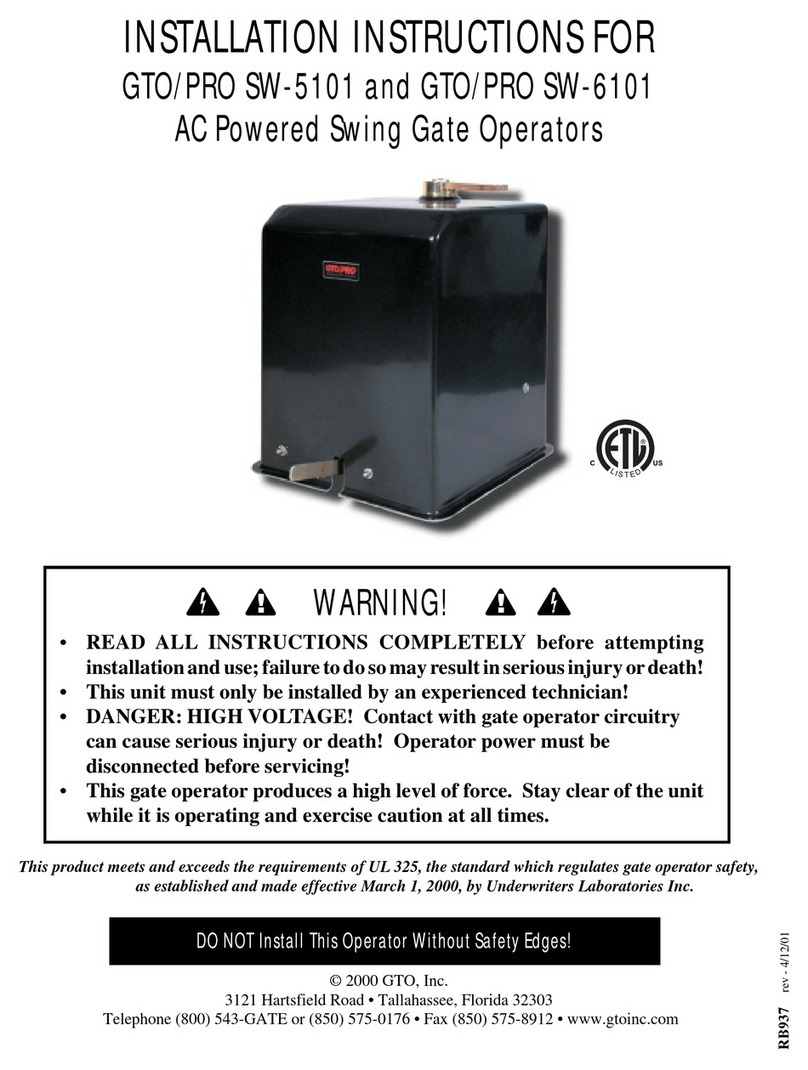
GTO
GTO /PRO SW-6101 installation instructions

Novoferm tormatic
Novoferm tormatic Novomatic 200 Installation, operating and maintenance instructions
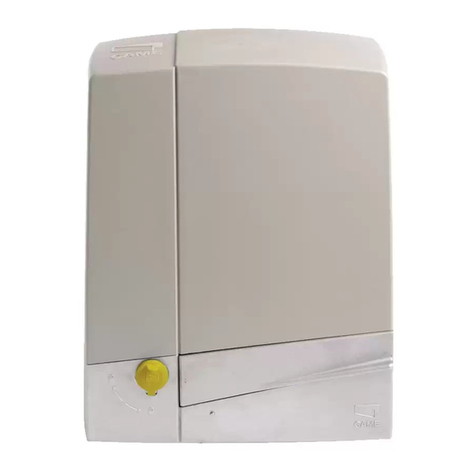
CAME
CAME SDN4 installation manual

RIB
RIB Duke 110 manual
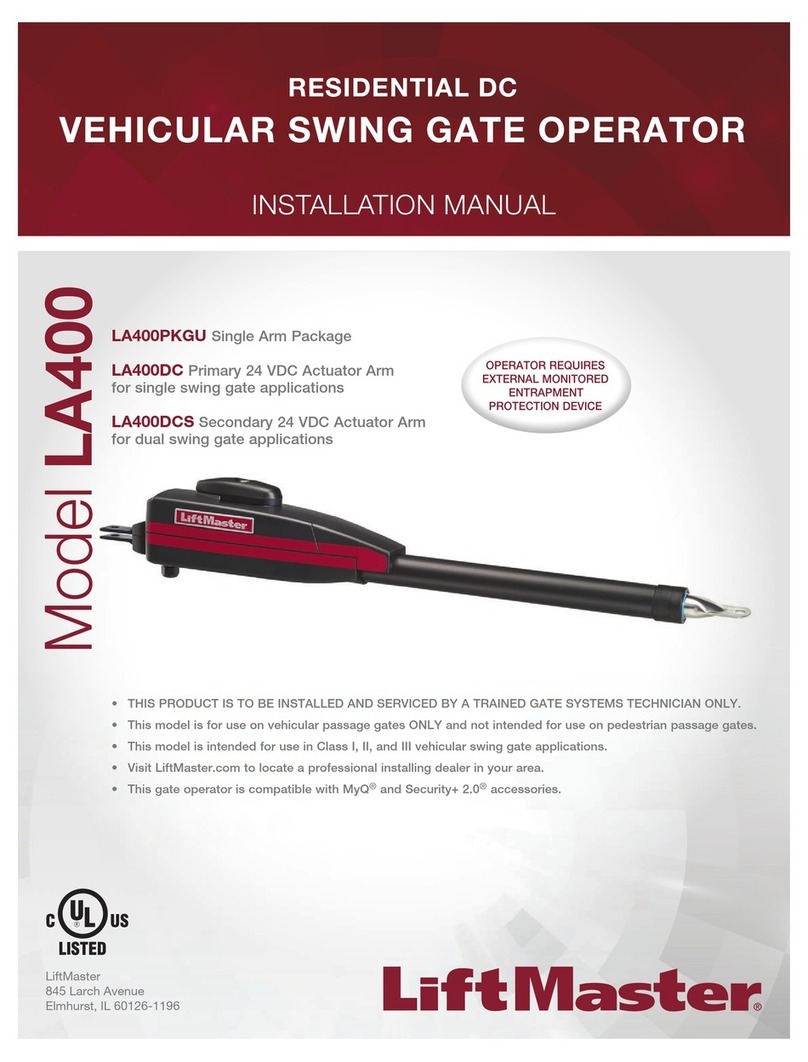
Chamberlain
Chamberlain LA 400PKGU installation manual
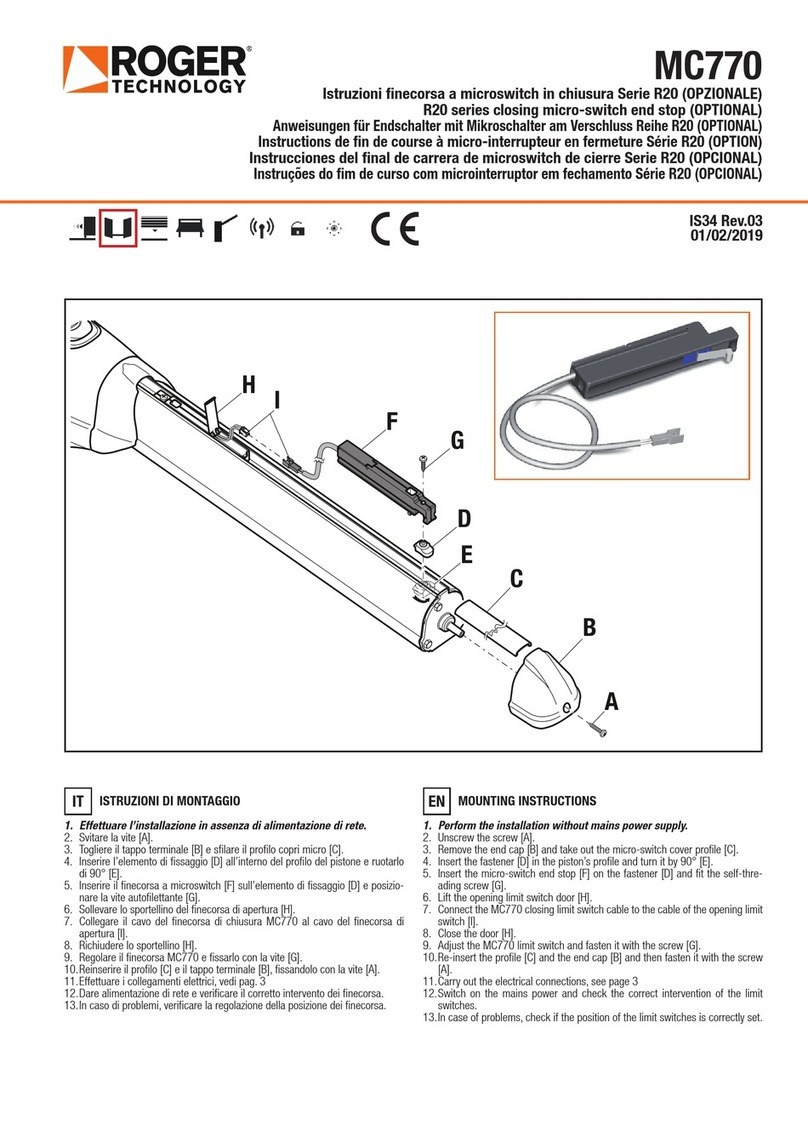
Roger Technology
Roger Technology R20 Series Mounting instructions
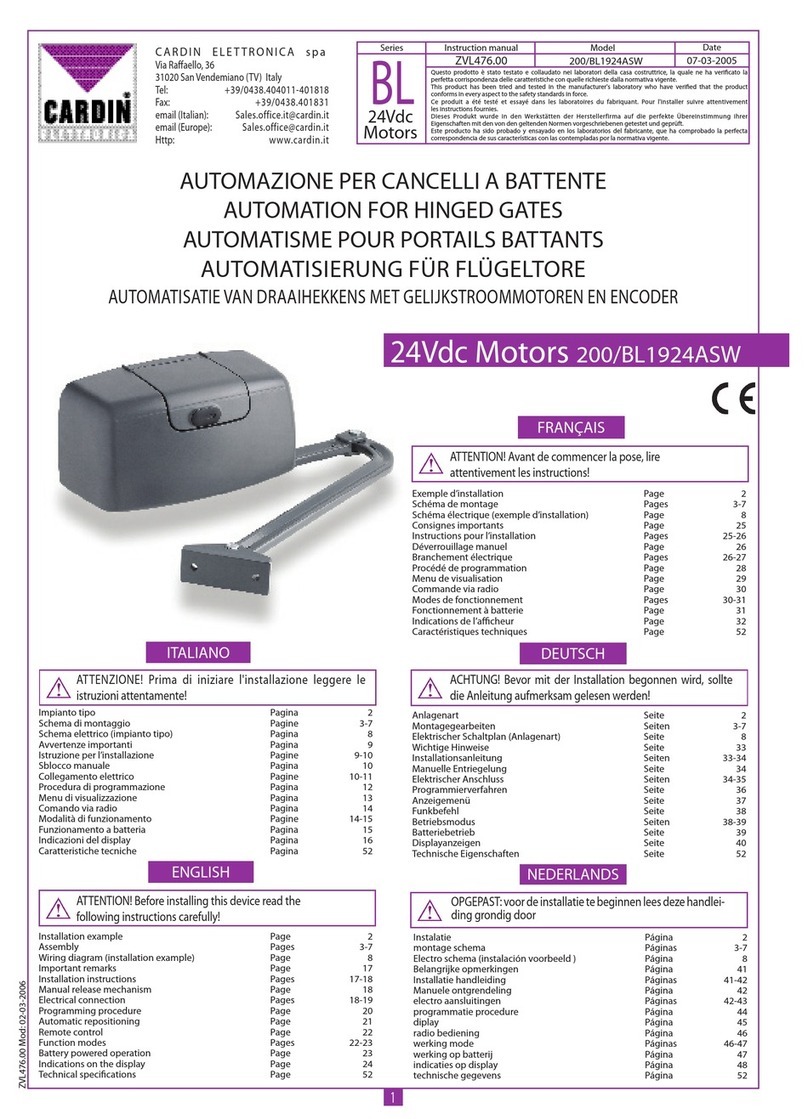
Cardin
Cardin 200/BL1924ASW instruction manual
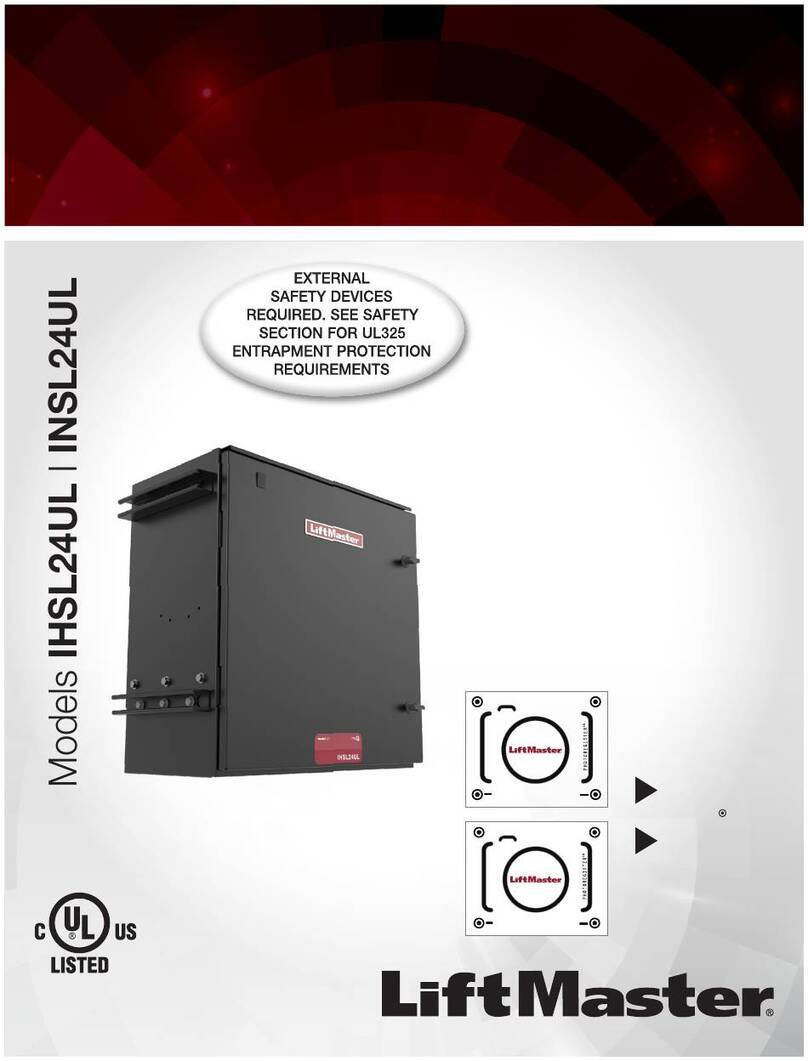
Chamberlain
Chamberlain INSL24UL installation manual

King gates
King gates Slim 1500 instruction manual
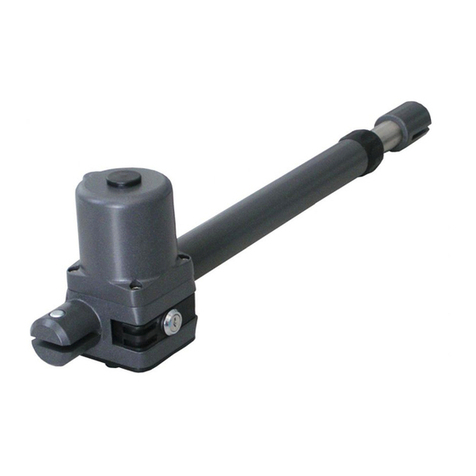
Proteco
Proteco leader ta Installation and use manual
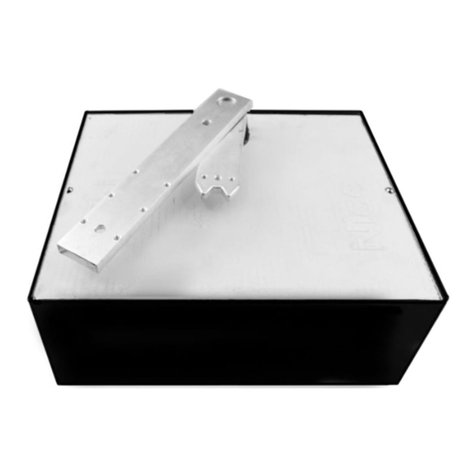
Nice
Nice BIG METRO Instructions and warnings for installation and use
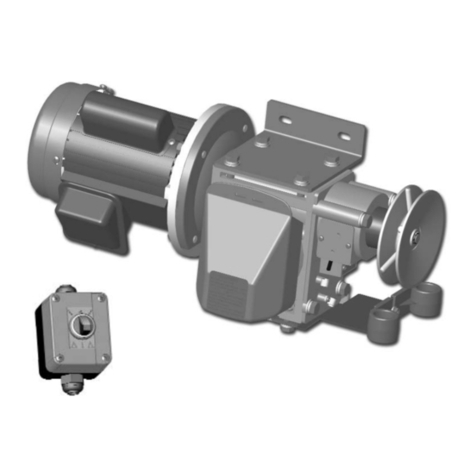
ATA
ATA AXESS 2000 Pro Series installation instructions
